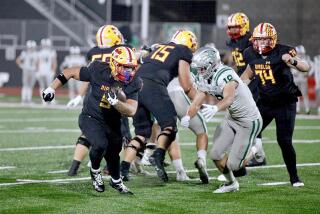Football Loses Its Footing at Long Beach : 49ers, in Battle to Save Sport, Face a Plight That May Be a Lasting One
- Share via
Not surprisingly, the recent football season at Cal State Long Beach was inglorious and unprofitable. With its passing, though, arrived a surprise--a threat that there may not be another season.
Although the hometown fans, in their traditional manner, mainly stayed away from old Veterans Stadium--average attendance was 6,300--the 49ers finished with a 6-5 record for their first winning season in three years.
But on Nov. 25, Stephen Horn, the university president, announced that because of an athletic department deficit, $300,000 in cash would have to be raised by Dec. 31 to pay for grant-in-aid scholarships, or football would be dropped.
In the wake of that shock, reality has jolted the athletic department.
John Kasser wore a grimace instead of a grin for the first time in his three years at Long Beach, knowing that the worst that can happen to an athletic director trying to build a strong Division I program was happening to him.
Coach Mike Sheppard, dismayed that Horn had made his announcement at the start of the recruiting season, has weighed other job opportunities. He fears that even if the money is raised, the heart will have been cut from the football program.
Sheppard, 35, who decided last week not to take the coaching job at Boise State, claims he isn’t bitter but says: “When you have hard-line budget decisions to make, there is a lack of concern for people, their lives, careers and futures. We’re totally on hold. (Prospects) don’t want to talk to us.”
The players are wondering where they will be the next time they put on a uniform.
“I don’t think it’s going to fall through,” quarterback Jeff Graham said. “I think the community will come through.”
Sheppard said that players would be immediately eligible to play wherever they would go if the program is dropped. But he also said: “Not all of them will have a chance to go someplace else.”
Team boosters are so infuriated with Horn that one longtime observer of Long Beach football characterized them as having a “lynch mob mentality.”
But that anger has been channeled into a burst of money-raising ideas, including a telethon and a telephone drive aimed at 4,000 alumni, and the passionate cry of “Save 49er football” has become the slogan.
“The city is shaking,” Kasser said, his smile back. “I’m really enthused.”
As of Wednesday, $48,928 in cash had been raised, with pledges of $59,050 more for a total of $107,978.
In an almost euphoric air, the boosters gathered at the football team’s banquet last week. Among them was Jeff Severson, a former Long Beach and National Football League player.
“You can see in the crowd here that there’s an emotional thing about this,” Severson said. “Maybe a crisis situation was needed to make people respond. We want to save football, we care about football, we’ll raise the money.”
Horn walked into the room and asked a city councilman to buy season tickets for next year.
Horn is perceived by many of the boosters as the villain, a man who, they say, does not care about athletics. They are mistrustful of his intentions.
“We need to spend money to make money,” Severson said. I played at Fresno when it was a cow pasture. Now they’ve got a beautiful stadium and everybody wears red. We could do the same thing 10 times bigger in Long Beach if there was a commitment.”
So the boosters have decided that if they raise the $300,000, it won’t be turned over to the 49er Athletic Foundation until they get a commitment from Horn that he will support athletics.
Horn, in his 17th year as president, denies that he doesn’t support athletics.
“I happen to enjoy the game,” Horn said. “It has my strongest support. I doubt if any president in America has attended more football and basketball games than I have.”
John Kasser, a popular 6-foot 6-inch former car salesman, arrived as athletic director at Long Beach in 1984 from the University of Houston and laid out his blueprint for building a strong Division 1-A program: “It takes a tremendous amount of money, and a tremendous commitment from the community and the campus,” he said. “And you’ve got to win.”
None of those factors has been in evidence.
The 49ers, with scholarships increased from 55 to 76, have been competitive. They almost won the Pacific Coast Athletic Assn. title last year and have played well against Pac-10 teams. But Sheppard’s three-season record is only 16-18.
“I couldn’t feel any better about our progress,” Sheppard said.
Long Beach has been concentrating on recruiting high school players instead of junior college transfers. And the emphasis has been on attracting local players.
“You’ll see that half of our players are freshmen and sophomores,” Sheppard said. “It’s right where you want to be if you could continue with your program.”
Considering the nature of football at Long Beach, there was an inevitability to the 49er plight.
Long Beach is a commuter school. Of its 31,000 students, only 1,700 live on campus.
“It’s not the type of college that generates rah-rah school spirit,” said Dave Radford, Millikan High School coach and a Long Beach graduate and former 49er assistant coach. “It’s a worker’s college. Most are there to get a degree and get out in the work force. Get in, get out, get after it.”
And the 49ers play their games five miles from the campus at Veterans Stadium, a 37-year-old, 12,000-seat structure that has long since seen its best days.
“(Horn) has never made an effort to get a stadium,” Severson said. “How are we going to induce cream-of-the-crop athletes to come here when we play in a stadium where I played junior high ball?”
The money to pay for scholarships must come from gate receipts or community donations. But the revenue from both sources has not been enough to sustain an ambitious Division I program.
Under Kasser, attendance has increased since the early 1980s, but the highest average in the last three years was 9,800 last season.
And after paying a guarantee of $30,000 to each visiting Pacific Coast Athletic Assn. there is little money left.
“You don’t make money when you play at home,” Kasser said.
Attracting big-name teams is impossible because of the stadium’s size and because Long Beach couldn’t pay what those teams would want as a guarantee for nonleague games.
“I think it would help if the facility was more conducive to playing in,” Kasser said. (A remodeling project at Veterans Stadium is scheduled next year.) “And it would help if we had 10,000 students on campus.”
The commitment of some of the Long Beach boosters has also been questioned.
Before the last game of this season, the 49ers had their pregame meal at a restaurant. Some of the team’s boosters were supposed to have been there to serve.
“Only one guy was there,” said Sheppard, who asked him, “Where are the other guys?”
The man answered, “They all went up to the SC-Notre Dame game.”
Before the end of the year, the 49ers must raise almost as much as the community has contributed--$330,000--in two years.
Horn, whose ultimatum included raising an additional $500,000 by June of 1988, said he has been disappointed for years at the attendance and at there being “no greater level of community contributions.”
He said: “There is probably no Division I-A program that has as low a level of contributions as this one.”
In contrast, Fresno State received $1.1 million in community donations last year.
Horn said he became alarmed in July about the problem of funding scholarships and the “hemorrhaging” in the athletic department.
“I knew we had a large deficit ($720,000 over the last five years) several months ago,” he said.
Each year, about $700,000 is needed to pay for athletic scholarships.
A committee, which included Kasser and John R. Beljan, vice president of academic affairs, was formed to study the problem. Kasser said that alternatives, including dropping other sports and going to Division III, were discussed. But the final recommendation, made in October to Horn by Beljan, was to drop football.
“They (Beljan and Kasser) wanted to call a press conference and end it right away,” Horn said. “I said: ‘I just can’t end it. You have to involve the community.’ If I had announced it earlier, it would have put a depressant on the season. The 31-8 loss to UNLV (Nov. 22) would have been blamed on the university president.”
Some say the delay in the announcement was Horn’s way of covering himself.
“I think the reason he did it was so he wouldn’t have to take sole responsibility if (football) dies,” said Gary Ellis, president of the alumni association. “He can say, ‘I gave the community a chance.’ I’m kind of disappointed if that’s the case.”
Despite Sheppard’s wish to get on with recruiting, Horn said he won’t rescind the deadline.
He said he picked Dec. 31 so the players would have an opportunity to transfer for the second semester, if they wish.
He also said the early response to save football has delighted him.
“But this can’t be a one-shot effort,” he said. “It must be a sustained commitment.”
Radford agrees that one year isn’t the answer.
“The only way to recover on recruiting is if Horn was to give Sheppard a five-year contract,” Radford said. “Or nobody will ever go there.”
Radford said Division I-A is probably the wrong place for Long Beach. “They should be playing the Northridges and the Cal Polies (Division II),” he said.
But Severson, who wants the team to be able to attract players so it can beat UCLA, has taken Horn’s threat as a personal affront.
“This hurts my ego,” Severson said. “I played here. How do you go back to the community you love, and feel you have pride that you graduated from Long Beach State, and someone says, ‘Guess what, Jeff, they don’t even have football anymore’? “
More to Read
Go beyond the scoreboard
Get the latest on L.A.'s teams in the daily Sports Report newsletter.
You may occasionally receive promotional content from the Los Angeles Times.










